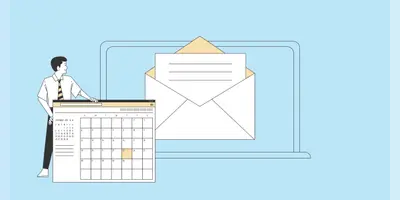In this email automation guide, you’ll learn everything you need to know about email automation: what it is, how it works, and its benefits. We’re also going to walk you through five steps to get started with email automation and give you three ways you can use it to improve customer experience and boost revenue.
We’ve got a lot to cover in this guide to email automation, so let’s get started!
Email Automation Guide: Get More Done In Less Time:
What Is Email Automation?
Email automation is the process of sending triggered emails to your subscribers automatically. Instead of broadcast email newsletters and one-off email marketing campaigns that require time to create, email automation lets you create an email or series of emails and set those emails up to send when a certain trigger is tripped.
One of the most common uses of email automation is the welcome email or welcome email series. Welcome emails are triggered by a signup to your marketing emails and are used to introduce yourself to your new subscribers, set expectations, and generally get the relationship started.
Creating a new welcome email for each new subscriber would quickly get tiresome and time-consuming. Setting up email automation to send those emails automatically will save you a ton of time and money.
How Does Email Automation Work?
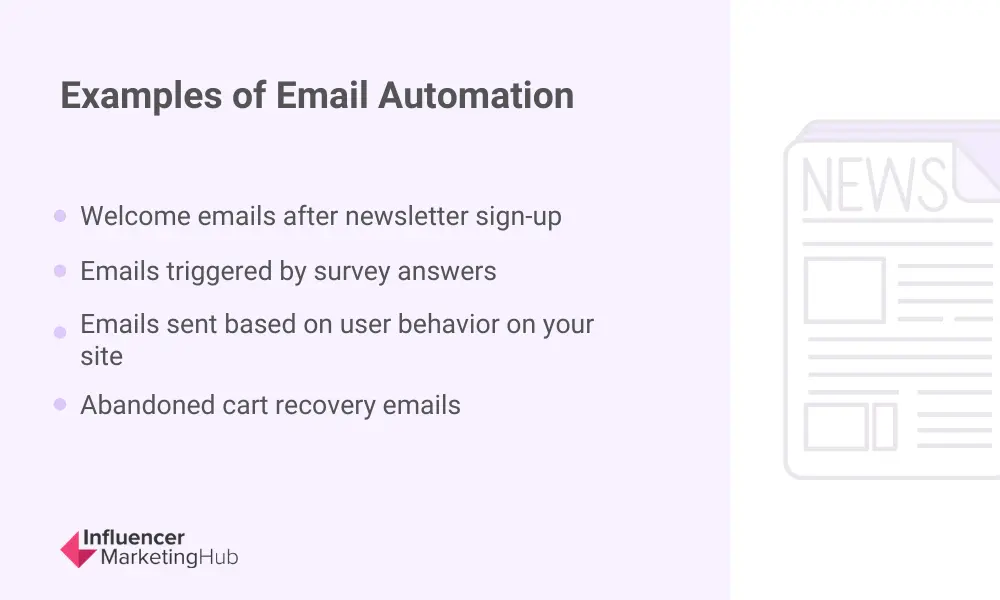
Email automation is actually pretty simple. You set up certain criteria that once met will trigger an email or email series to be sent. Email automation lets you create automated email marketing workflows that require no additional effort on your part once they’re created. Here are some examples of email automation at work:
- Welcome or confirmation email after email list signup
- Specific emails triggered by survey answers
- Emails to subscribers when they visit your website again
- Abandoned cart recovery emails to push shoppers to complete a purchase
Benefits of Email Automation
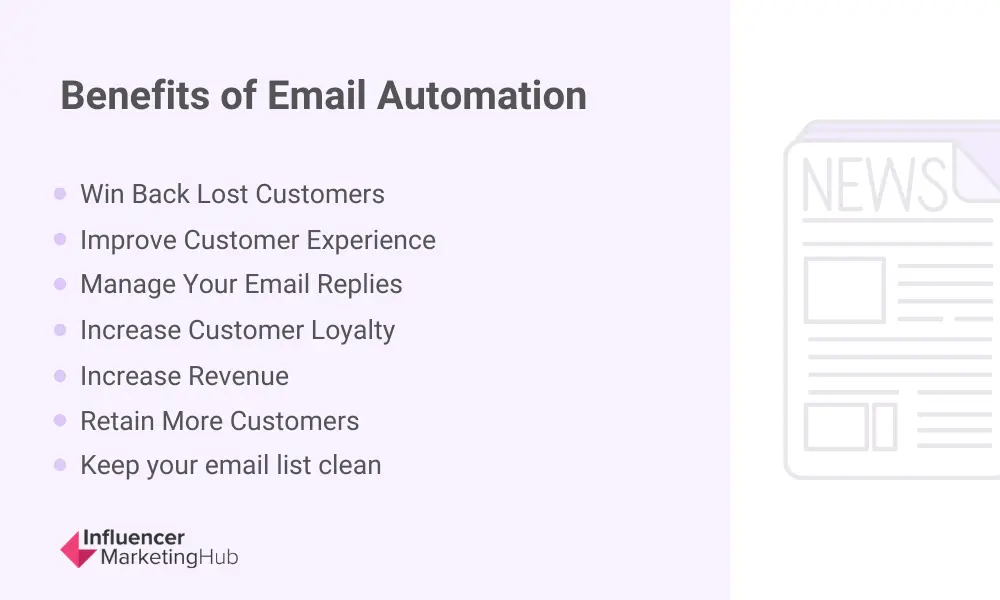
According to Campaign Monitor, automated email campaigns account for 21% of email marketing revenue. They also have a 70.5% higher open rate and a 152% higher click-through rate than the standard email newsletter. And, when you automate your email marketing, you’re free to focus on other aspects of running and building your business instead of babysitting subscribers.
Not convinced? Check out our post on marketing automation statistics to learn more.
Email automation has quite a few benefits. Let’s take a closer look at a few of them.
Win Back Lost Customers
It’s likely you have several prior customers on your list who haven’t purchased from you in a while. Instead of continuing to send them your standard email newsletter and hoping they’ll come back, you can use email automation to create and send a win-back campaign. Here’s what a win-back campaign might look like:

Source: reallygoodemails.com
We recommend creating different win-back campaigns based on the segments that are most important to you. This could be past customers who have spent more than a certain dollar amount with you or customers who haven’t made a purchase within a certain timeframe.
Improve Customer Experience
Subscribers love personalization. According to Moosend, 75% of email revenue is generated from personalized campaigns. And, personalized emails deliver 6X higher transaction rates (Instapage). But if you’re manually writing each and every email, you’re wasting time.
Using email automation tactics will help you create a personalized and unique customer experience without spending all your time manually segmenting, writing, and sending emails. Most email automation tools include functionality that allows you to tag, segment, use dynamic content, and so much more. Here’s a great example of a personalized email:
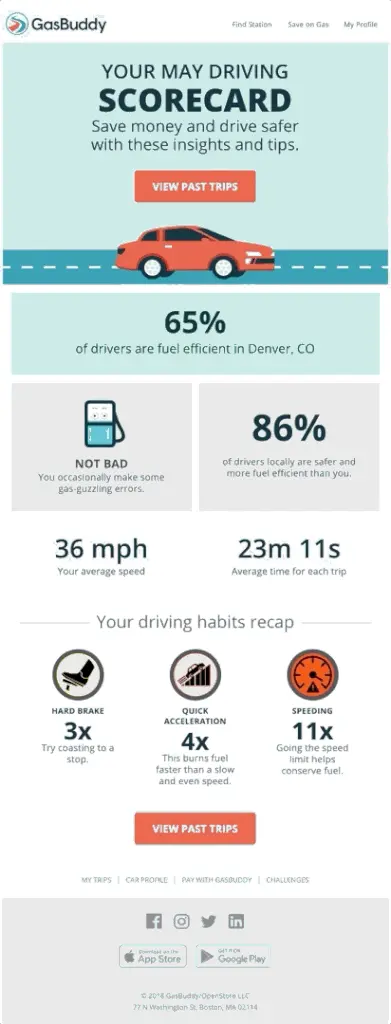
Source: reallygoodemails.com
Notice that the email feels personal like the company knows you and knows what you want. This makes it much more likely that you’re going to listen when the company makes suggestions to you about what to purchase. Consumers want a personalized experience; email automation makes it a lot easier to give them one.
Manage Your Email Replies More Efficiently
Email automation can help you manage your email replies without having to manually answer each of them. You can set up autoresponders within your email marketing service to handle the responses that come in so you’re nurturing your leads and nothing falls through the cracks. Here’s an example of what an autoresponder might look like:

Source: reallygoodemails.com
You can also connect your email marketing service with your CRM software to keep your sales team in the loop. And, depending on the live chat software you use, you might be able to move the conversation from email to real-time chat.
Increase Customer Loyalty
Another benefit of using email automation is the speed with which you can reply to emails from your customers and subscribers. With the right mix of email marketing services and CRM software, you can keep your sales and support teams ready to jump in at a moment’s notice which is a sure-fire way to endear customers to your brand.
You can also automate recurring communications with your subscribers to let them know that you’re thinking about them and value them. This might include scheduling promotions, sending birthday and anniversary emails, event notifications, and more. These emails keep you at the front of your subscribers’ minds and help you build relationships to increase customer loyalty. Here’s an example of a birthday email:

Source: reallygoodemails.com
Keep Your Email List Up to Date
Did you know that your email list declines at about 22% every year? This can impact open rates, click-through rates, conversions, sales, and a whole lot more. That’s why we recommend using email automation to help you get rid of those email addresses that are out of date, bouncing, or just haven’t been engaged with your email marketing campaigns in a while. Here’s an example of what a list clean up email might look like:

Source: reallygoodemails.com
To keep your list full of interested and engaged leads take a look at our tips to grow your email marketing list.
Increase Revenue
Email automation makes it easy to create multiple campaigns that can be scheduled or triggered at different times to meet different needs. You can automate campaigns to win back lapsed customers, promote your customer loyalty program, recover abandoned carts, share custom promotions with certain segments, and more. Here’s an example of an abandoned cart email:

Source: reallygoodemails.com
Retain More Customers
Email automation is one of the easiest ways to retain existing customers. When you segment your email list you can create personalized, automated email marketing campaigns that deliver the content and promotions your subscribers want. When your subscribers and customers get their needs met, they’re more likely to stick around. Here’s an example of a promotional email:

Source: reallygoodemails.com
Email Automation Guide: 5 Steps to Success
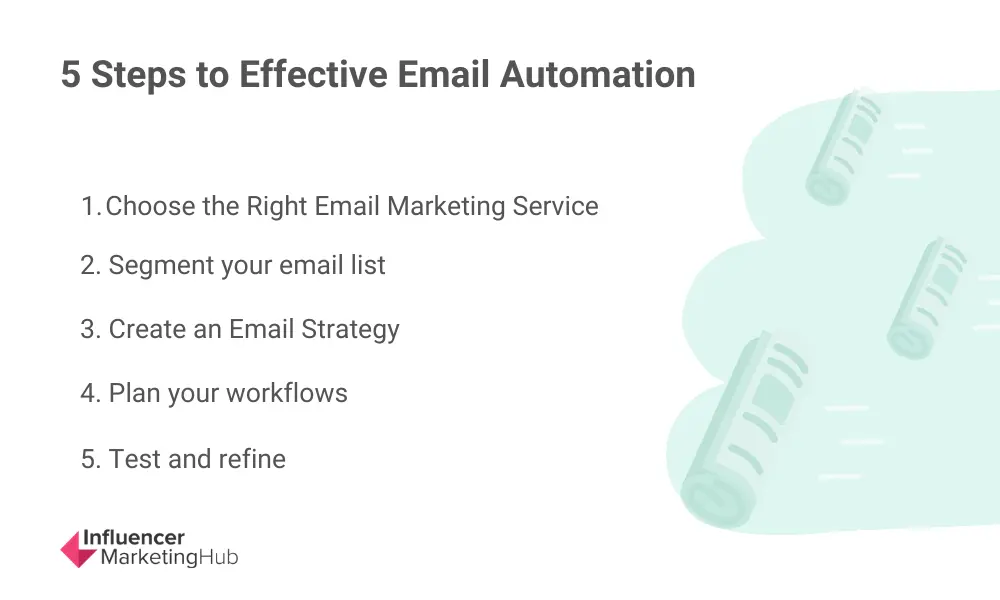
Email automation isn’t hard to do. While it does take some work upfront, automation more than pays for this investment. But if you’ve never done any email automation, you’re probably wondering how to get started. Keep reading… In this section, we’re going to share five steps you can take to get started with email automation.
1. Choose the Right Email Marketing Service
Choosing the right email marketing service is important for email automation. There are so many email marketing services on the market, so it can be hard to figure out which one is the right one for your business. Since you’re interested in email automation, you need to make sure that the email marketing service you choose includes the automation tools you need. While you probably don’t need all the bells and whistles that come with enterprise-level software, you’ll want to consider an email marketing tool that gives you room to grow. Here are a few of our favorite email marketing services that offer excellent automation features:
- Constant Contact. Offers tools that automate the process of collecting leads, staying connected with leads, and retaining customers.
- Sendinblue. Includes beginner and advanced workflow examples.
- GetResponse. Includes tools to build an automated customer journey.
- ConvertKit. Visual email automation tools to create marketing funnels, send targeted content, and segment subscribers based on their customer journey.
- Mailchimp. Create custom marketing workflows, send trigger-based transactional emails, and schedule your email marketing campaigns.
2. Segment
Segmenting your email list makes it a lot easier to create automated workflows. You can segment your email marketing list in any number of ways—behavior, demographics, psychographics, location, purchase history, and just about anything else you can think of. Instead of having thousands of segments, consider who are the most people you want to reach. If you don’t have location-based promotions, for example, it doesn’t make sense for you to segment based on location. Really think about who your target audience is and create segments that represent each of the audiences you’re trying to reach.
3. Create an Email Strategy
A plan is mandatory for email marketing, in general, but it’s particularly important for email automation. Start by analyzing the data you already have about your subscribers and build your email automation based on that. This might mean using an email signup as a trigger for a welcome email series or sending re-engagement campaigns to subscribers who haven’t engaged with your emails in a while.
Start with a simple email automation strategy and move on from there. You don’t have to create an entire catalog of email automation in one go. We recommend starting with a welcome email series of 5–7 emails designed to introduce your brand to new subscribers and set the stage for a strong relationship before moving those new subscribers over to your standard email newsletter mailings.
The second email automation we recommend for eCommerce businesses is an abandoned cart recovery email or email series. Globally, 75.6% of carts are abandoned (SaleCycle) costing eCommerce businesses more than $18 billion every year (Dynamic Yield).
That’s a lot of money to leave on the table.
An abandoned cart recovery email series can give shoppers the nudge they need to come back to your site and complete their purchase. While it’s true that 40% of shoppers put products in their carts without any intention of buying them (Annex Cloud), that leaves 60% of shoppers who intended to complete their purchase but didn’t for some reason. An abandoned cart recovery email series can mean the difference between making the sale or losing it.
Looking for more ways to improve your eCommerce marketing? Here are 6 eCommerce email marketing tips you can use to boost revenue.
4. Plan Your Workflows
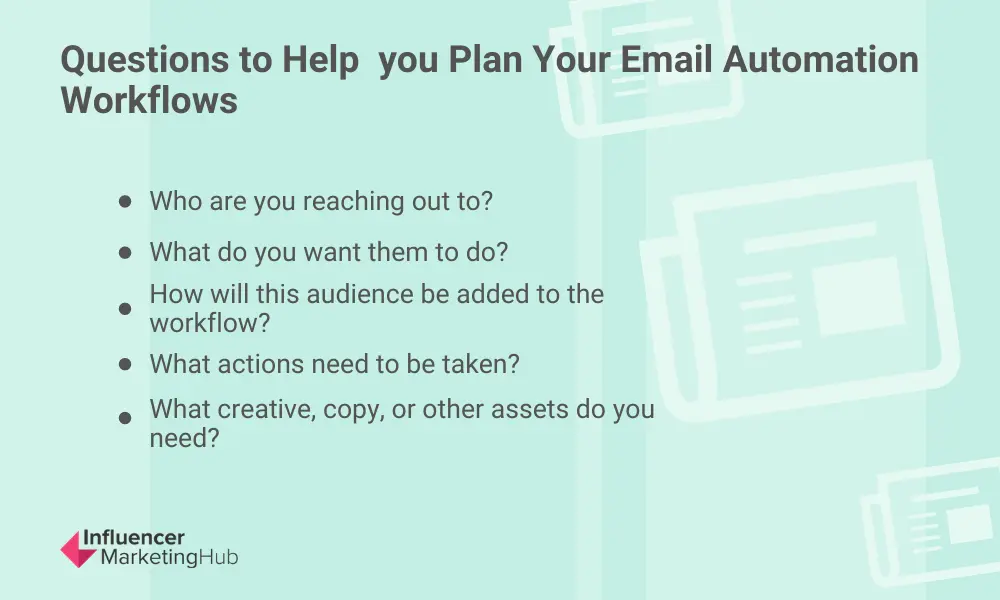
Now that you have your email strategy, the next step is to plan out your workflows. Every email marketing service has a different way of building workflows, so look to the help or support sections of your chosen service’s website for complete details. Here are some of the things to consider when planning your workflows:
- Who are you reaching out to?
- What do you want them to do?
- How will this audience be added to the workflow?
- What actions need to be taken?
- What creative, copy, or other assets do you need?
After you’ve answered all of those questions, you’re ready to set up your workflow in your email marketing service and test it.
5. Test and Refine
Once you have your workflows in place, it’s time to test and refine. Your email marketing tool should provide comprehensive reporting on the email marketing benchmarks you care about (open rates, conversions, click-through rates, etc.). Use this data as a starting point before you start A/B or split testing your workflows and emails. This will help you find the email subject lines that get the best open rates or the offer that gets conversions.
3 Ways to Use Email Automation to Grow Your Business
We’ve covered a lot already in this email automation guide but wanted to make sure that we left you with a few concrete ways you can use email automation to make a real impact on your business.
1. Automate Your Welcome Emails
Create a welcome email series of 5–7 emails to introduce your new subscribers to your brand, build brand affinity, and move those subscribers deeper into your marketing funnel. Here’s a sample welcome email series so you can get a feel for what to include in each email:
- Welcome. Use this email to fulfill your promise (if a user signed up for a lead magnet). You should also share information about your business, links to some of your best content, and links to your social media profiles.
- Learn more. A couple of days after your welcome email, send another email that talks more about your business and the products and services you offer.
- Education. This email will go out a couple of days after email #2 and should include information about how your business is uniquely poised to solve a specific pain point your subscriber has.
- Small ask. In this email that’s sent out a couple of days after email #3, you’re asking subscribers to commit to something small to get them primed to say “yes” to bigger asks in the future. This could be something as simple as asking them to follow you on social media.
- Bigger ask and a coupon. In the final email of your welcome email series, you should share information about your products and services as well as a coupon or some sort of enticing offer.
2. Automate Your Abandoned Cart Recovery
Your abandoned cart email series doesn’t need to be as long as your welcome email series. We recommend using 3 emails in this series. For abandoned cart recovery, timing is critical. Here’s a sample series you can adapt to your needs:
- One hour email. About an hour after a shopper abandons their cart, send them an email with a reminder about the items in their cart, images of the products they’ve left behind, and a simple call to action like Complete Your Purchase.
- One day email. If your one hour email didn’t work, send another email the next day. In this email consider including social proof, benefits of the abandoned products, or a guarantee to reduce risk.
- Five day email. If your first two emails didn’t work, hold off for a few days before sending your final email. In this email, you’re going to give a discount to the shopper to get them to complete their checkout. This isn’t something you should do every time (your shoppers will come to expect it), but it’s a great way to recapture more of your abandoned cart revenue.
3. Automate Your Lead Nurturing Sequences
Lead nurturing sequences are necessary for moving subscribers deeper into your marketing funnel and leading them towards a conversion. Welcome emails are a form of lead nurturing sequence, so you can use a similar workflow. Five emails is pretty good for a lead nurturing sequence. Here’s an example of a lead nurturing sequence.
- Email #1. This email is sent immediately after the trigger is tripped. The trigger could be a lead magnet download, free trial signup, or even a purchase.
- Email #2. In this email, you’ll want to address your subscriber’s pain points and how you can solve them.
- Email #3. Provide social proof to support your claims that you can solve your subscribers’ problems.
- Email #4. Use this email as an opportunity to let subscribers know that you understand their pain (empathy).
- Email #5. In this last email of your lead nurturing series, you want to make a hard ask. Your call to action is all about making a purchase and you’re not being shy about it.
Conclusion
Email automation has a lot of moving parts but it doesn’t have to be time-consuming or complicated. In fact, it should be the opposite of that! Using the tips and email marketing templates in this email automation guide will get you off to an excellent start towards achieving your email automation goals. Start small and focus on the segments of your audience that are most valuable to your business before branching out into other segments to increase your sales even more.


